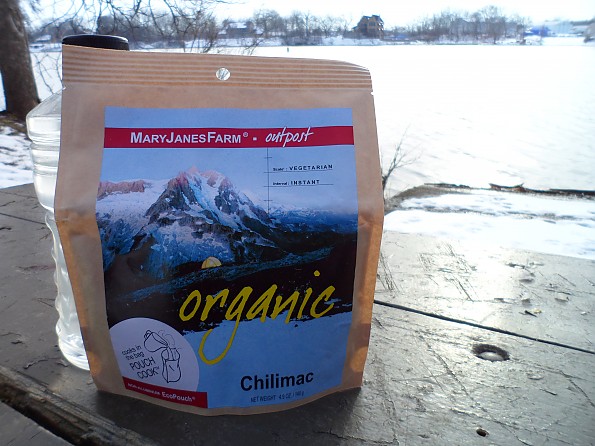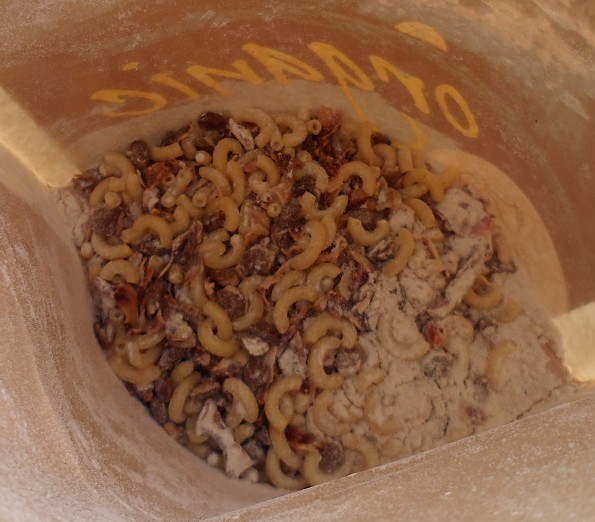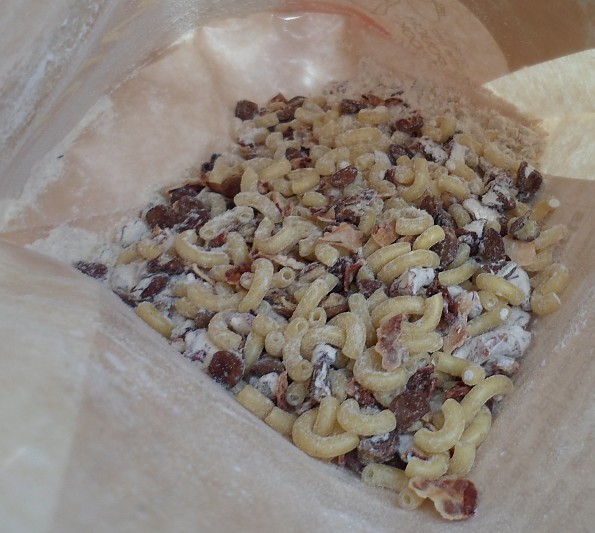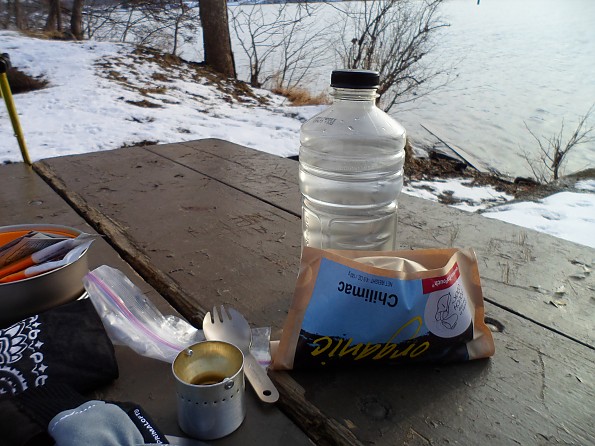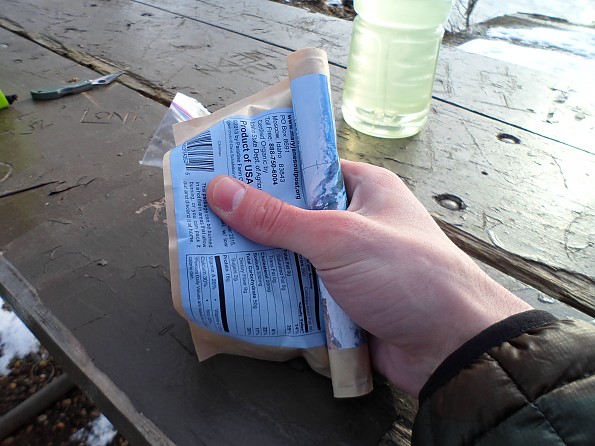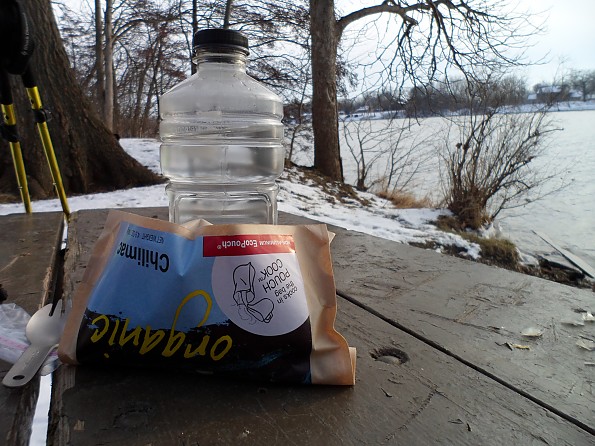Mary Janes Farm Organic Chilimac
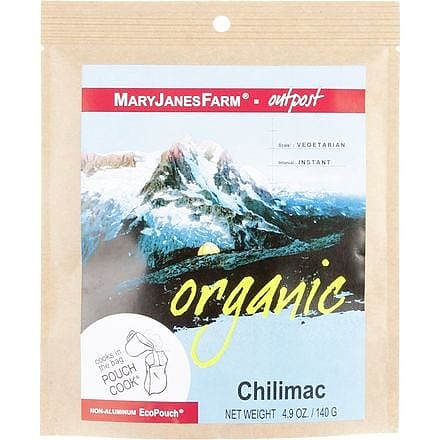
MJF strips this backpacking staple down to the bare essentials, offering a chili mac made from pasta, beans, and a cheese sauce that binds the aforementioned together without overwhelming them or making the dish a soup. Elevated with a smoky, natural blend of spices and seasoning, this is a meal for which you can leave the spice rack at home. It's cow-friendly, too, and the lack of any and all beef makes it a prime meal choice for your vegetarian friends.
Pros
- Simple, uncomplicated rendition of a traditional backpacking meal staple
- Higher ingredient-to-sauce proportion
- Vegetarian
- Natural smokiness from natural spices and seasonings
- Packaging can be burned in a hot fire instead of requiring to be packed out
Cons
- Small portion size
- Requires more water and rehydration time than suggested
- Eco-friendly packaging may not last as long as traditional, foil-based packaging
- Meatless
- Packaging lacks a re-sealable closure
MARYJANESFARM - ORGANIC CHILIMAC
PRODUCT INFORMATION
Meal: ORGANIC CHILIMAC
Manufacturer: MaryJanesFarm Outpost
Year of Manufacture: 2013
Expiration Date: Mar 2015
Website: www.maryjanesoutpost.org
Weight, Listed: 4.9 oz
Serving Size: Single
MSRP: $9.50
Description: Beans, Cheese, Pasta
Special Dietary Needs: Organic, Vegetarian
NUTRITION FACTS
Servings Per Container: 1.5 (1 cup per serving)
Calories Per Serving: 350
Calories From Fat: 80
Total Fat: 9g (14% DV)
Saturated Fat: 5g (25% DV)
Trans Fat: 0g
Cholesterol: 20mg (6% DV)
Sodium: 530mg (22% DV)
Carbohydrates: 50g (17% DV)
Dietary Fiber: 8g (32% DV)
Sugars: 2g
Protein: 18g
Vitamin C: 15% DV
Vitamin A: 20% DV
Calcium: 30% DV
Iron: 20% DV
Daily Value "DV" based on a 2,000-calorie diet
This meal really rocks when it comes to sodium content.
For comparison, Chili Macaroni with Beef from Backpacker's Pantry has 1,330mg PER SERVING. ZOINKS.
And even the Chili Mac with Beef from Mountain House has 650mg per serving.
Mind you, this usually means you'll be eating twice that amount, if you polish-off a full 2-serving bag all by yourself. Don't be saving these meals for "zero" days - you'll feel a lot better about yourself if you've put in big miles and earned it.
MJF's Chilimac does, however, have twice the saturated fat either of the aforementioned meals does, so don't think you're getting off entirely scott-free on this one.
INGREDIENTS
Instant Durum Semolina Pasta*
White Sharp Cheddar Cheese* (cheddar cheese* (milk*, salt, cheese cultures, enzymes {vegetable rennet}), whey* salt, lactic acid, citric acid, natural mixed tocopherols)
Lentils*
Pinto Bean Flakes*
Tomatoes*
Onions*
Red Bell Peppers*
Garlic*
Herbs* & Spices*
Sea Salt
* = Certified Organic
Processed in a facility that handles dairy products, nuts, peanuts, soy and wheat.
As the saying goes, ya get what ya pay for. Since their ingredients list doesn't require a chemistry major to decipher, and composed mostly of recognizable items, the meal even looks organic. Cheese by nature is a fermented product that doesn't exist naturally, so you have to assume it's going to require a little chemical help to become dehydrated and preserved. Gotta give 'em that much.
This meal will bode well with your cow-hugging friends, as it's not only organic, but 100% vegetarian, too.
FIRST IMPRESSION
When I first started backpacking, I went by the old, tried-'n-true "gold standard" with freeze-dried meals, and bought mine from Mountain House. They're cheap (under ten bucks), easily accessible (available from "big box" retailers in addition to specialty outdoor gear stores), and give you a lot of bang for your buck with generous serving sizes. After making my way through the canon that is the MH menu, my taste buds grew bored and started looking elsewhere for new meals and flavors.
The only thing about me hugging trees is usually the straps on my hammock, but I came across the MJF meals on my weekly trip to REI, and decided to give them a try. Since there're few things worse than a disappointing meal after a long, strenuous day of hiking, I always "audition" my meals first at home. If I like them, I buy more, and if not, I don't ever have to subject myself to that particular meal again. Ever.
As much as I like my Mountain House meals, my blood pressure doesn't like how much sodium is in them - sometimes more than your entire daily value in a single meal! MJF's version of the backpacking staple offered the lowest sodium content of any I've seen, and for that reason alone, I purchased this meal.
Organic?
That's cool, too — good to know what I'm eating comes from a farm field and not a chemical laboratory.
Vegetarian?
Better news for the cattle herd than myself, but hey, not a bad thing, either.
STORAGE AND PACKING
When you're at home, before you hit the trail, the manufacturer recommends you keep them someplace cool and with low humidity.
The expiration date can be found on the back side label, near the bottom center.
Hold the bag upright and tap the bottom against a hard, flat surface to let the contents settle toward the bottom.
This enables you to fold the [now] empty, top half down and makes the meal easier to pack.
Backpacker's Pantry seals their meals with the contents evenly distributed throughout the entire package, top to bottom, and it makes packing them a pain in the @#$. Despite their gusseted bottoms, it takes some pretty dedicated and forceful shaking to get them to settle. Save that chore for a day the commute home takes twice as long as it normally does.
That said, packability is a big selling point for me.
FIELD USE - TRIP INFORMATION
Testing Date: Monday, January 20, 2014
Testing Location: Illinois and Michigan Canal State Trail
Description of Location: Section Hike, McKinley Woods Forest Preserve to Dresden Access
Weather Conditions: 34°F, snow-covered ground, with a clear and sunny sky
Miles Hiked: 6.0
FIELD USE - PREPARATION AND REHYDRATION
Cooking Gear Used: Snow Peak Hybrid Trail Cookset / UL Designs Blue-Mini Alcohol Stove
Eating Gear Used: Eaten from Bag, with a Snow Peak Titanium Short Spork
Fuel Used: 1 oz Denatured Alcohol
Water Required, Suggested: 1 cup
Water Required, Actual: ~1 1/4 cups
Rehydration Time, Suggested: 10 min
Rehydration Time, Actual: ~15 min
MJF on the general whole tends to require less water for their meals. Though an extra 1/2 cup of water doesn't sound like much, sometimes that's the difference between having enough until morning, or making another run to my water source to refill.
Like most freeze-dried meals, these can be prepared and eaten from the bag they're packaged in.
On colder days, they also make a damn good hand-warmer.
Nice to know it's good for something other than a paperweight during that 10 (or 15) minute rehydration period.
MJF pouches are gusseted to help the bag stand on its own, however, in making them eco-friendly, they lack a resealable closure. This isn't a problem so long as you squeeze all the food toward the bottom of the bag (removing any excess air) and roll the top down tightly. I tend to let them rehydrate upside-down, carefully resting against a stationary object. This has a two-fold benefit, using the weight of the bag to maintain the seal, and allowing gravity to push the contents at the bottom of the bag downward to more evenly rehydrate them.
EATING
Some folks carry longer, heavier spoons to reach bottom on their freeze-dried meals. I use a short spoon. How?
I cut the tops off my bags.
Since they lack a resealable closure, you will have to place the empty bag in a secondary trash bag or container if you have to pack them out. Whether or not you trim the package down, it still has to be either burned or packed out.
TASTE
Either I was a bloodhound in my past life, or you can smell the seasoning straight through the package. A smoky, spicy hint of chili powder (or cumin, maybe) hits you right away. The bad news? The eco-friendly packaging lets smells through, and can't bode well for packing these in bear country or for keeping these shelved for lengthy periods of time. The good news? It's a smell that comes from a natural, and more importantly, recognizable spice.
It tastes like a really simple chili mac.
"Simple" is meant as a compliment, here.
Normally, these chili mac meals come slathered in a red-brown sauce in which all the other components sit. It's clear to see that the beans and pasta are the key elements here, bound together and flavored with a white cheddar cheese sauce. I didn't mind the lighter sauce at all. If anything it made it much easier to eat, and definitely easier to clean up afterward.
The little red flecks of tomato and red bell peppers are a nice touch - both a visual nod to the usual red sauce, and reminding you that every element of the dish is recognizable.
And, strangely? I really didn't miss the beef.
Ground beef in dehydrated meals is a hit-or-miss affair, and when it's not properly rehydrated, you find yourself wishing you went without it.
This meal had both enough flavor and texture that it didn't really require anything more beyond what it already had. So much so, I didn't even add a single condiment to it. Didn't need 'em.
CONSISTENCY
1 cup of water and 10 minutes of rehydration time were both not enough for this meal.
I don't mind a thicker sauce (I actually prefer it), but some of the noodles and beans still were on the crunchy side.
If it wasn't the middle of winter, and I didn't mind spending long periods of time without gloves on my hands, I'd have boiled a little more water and waited a little longer. It isn't a problem that can't be solved, but it is a problem the manufacturer wouldn't have you be aware of, based on the requirements they present.
Even so, it sits well on a spork - so much so, this thing was gone in less than five minutes. I was able to scoop up big bites, and nary a once did I drop a noodle getting that spork from the bag into my mouth.
Unlike some other company's cheeses and sauces - MJF's never aggressively stick to your spork and add time to your dishwashing routine. This one's so good, you'll probably have it licked clean before you bust out the 'ol Bronner's.
BEST SERVED
At lunchtime, or as a dinner entree accompanied by a side dish.
CONDIMENT(S) USED
None! Didn't help I don't pack condiments for day hikes, but it was flavorful enough on its own to not require any additional seasoning or texture.
If you'd like more crunch, or want to stretch the smaller portion size, add some crumbled tortilla or corn chips. Frito pie, trail style!
If you're a masochist and want your mouth to self-immolate, go right on ahead and dash (pour?) that hot sauce right on in.
And though the white cheddar sauce is thick enough, generously coating the entire meal (opposed to a percentage of it), I don't think a little grated cheddar would hurt this dish, either.
SATIETY
For what it's worth, I've gotta say that a meal branded as a "single serving" also lists nutrition facts claiming that there are 1.5 servings per container. MJF isn't the only brand guilty of this, and most companies do quote serving sizes on the low end. However, it suggests either A.) a product that looks healthier than it is at first glance, or B.) a larger amount of food than it actually is. Because this is a meal on the smaller side (requiring a side dish of some sort), I wish they'd just list the values for the entire bag.
Filling? Yes, for six miles that required nothing more than a light lunch.
For a distance any longer than that, I'd suggest snacking prior, or serving this meal with some sort of side dish, soup, or appetizer.
DISPOSAL
MJF meal packages can be disposed of in a fire (the eco-friendly packages are free of aluminum), so you needn't worry about packing them out when you're able to burn them. Lucky for me, I ate my lunch at a campsite along the canal, and they'd trash cans available there (which are maintained through the winter, thankfully).
SUMMARY: WOULD I USE THIS AGAIN?
Sure thing! But I would only use this as a meal for myself, and no more people than that, and either save it for lunchtime, or eat something else with it to make it more filling.
3.5 stars, because I wish the portion size was proportional to the amount of flavor.
You think it's a coincidence that elbow macaroni is shaped like a smile?
THINGS LIKED / PROS
Simple, uncomplicated rendition of a traditional backpacking meal staple.
Natural smokiness from natural spices and seasoning.
Vegetarian.
Higher ingredient-to-sauce proportion.
Packaging can be burned in a hot fire instead of requiring to be packed out.
THINGS DISLIKED / CONS
Small portion size.
Requires more water and rehydration time than suggested.
Eco-friendly packaging may not last as long as traditional, foil-based packaging.
And when you've a view like this from your dining table, how bad could lunch possibly be?
Source: bought it new
Price Paid: $9.50
Your Review
Where to Buy
You May Like
Specs
| Price |
MSRP: $7.05 Historic Range: $5.93-$7.05 Reviewers Paid: $9.50 |


